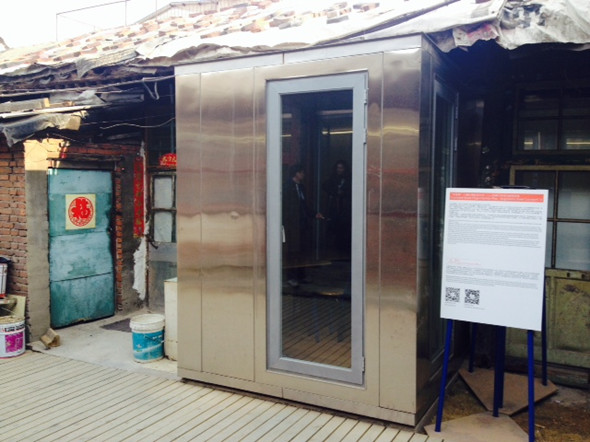
The box is inserted into existing structure, instead of rebuilding or renovating the delicate house. (Photo: Ecns.cn/Ruisha Qian)
(ECNS) -- A short walk south of Tian'anmen Square, the Dashilar District, dotted with hundreds of old-fashioned courtyard houses, is quite a different picture from nearby Qianmen, a bustling commercial strip.
Off the main alley in Dashilar, courtyard 72 sits quietly behind the location of a time-honored pharmacy called Ji'antang.
Pushing open a tiny wooden door, one can see that the original structure of courtyard 72 is in a state of decline. The wood pillars have tilted and waterproof cloths have been placed on the roof to prevent leaks, while piles of discarded furniture and a makeshift kitchen in the yard make the house look even more dilapidated.
One room on the right, about 10 square meters in size, is occupied by a trash collector who pays roughly $80 a month. Another room about the same size is shared by 62-year-old Dong Xuemei and her son.
Amid the squalor next to Dong's room stands a shiny stainless steel box about 6.5 feet tall. Inside it is a bedroom lit with warm yellow light and a bathroom with sleek faucets, showerhead and toilet.
The box is a prefabricated modular with built-in cables, plumbing and insulation, an innovative project by the People's Architecture Office (PAO) to plug modern living into these century-old courtyard houses.
"The problem with these courtyards is that they're very old," says PAO's co-founder James Shen. "They're cold in winter, the rooftops are leaking, and there's no toilet."
Shen and his team spent over a year researching for a new design that integrates several materials into one panel, enabling it to have multiple functions. The lightweight panel is referred to by the team as "quicklock," which can easily be snapped together into a box with a single hex wrench, according to PAO's co-founder Zang Feng.
They've also dug a new drainage system under the yard, which solves what is perhaps the biggest problem of Beijing's courtyard houses – a lack of basic plumbing. With no private toilets or showers, many residents must walk the alleyways and use public facilities.
The cost of the bedroom "plugin" was around $500 per square meter, not including the drainage system, according to Shen.
The plugin is part of the Dashilar Pilot program to revitalize the old neighborhood without erasing its past. At the annual Beijing Design Week held in late September, Dashilar invites archeologists, designers, artists and residents to come up with innovative designs.
Shen's team brought the idea to the 2013 Design Week and presented the materials a year later. Since then, the team has finished the bedroom plugin and a larger one in the room across the yard. It's used as an office by Dashilar Platform, founded by Beijing Dashilar Investment Limited -- the state-owned company responsible for the area's renovation.
















































